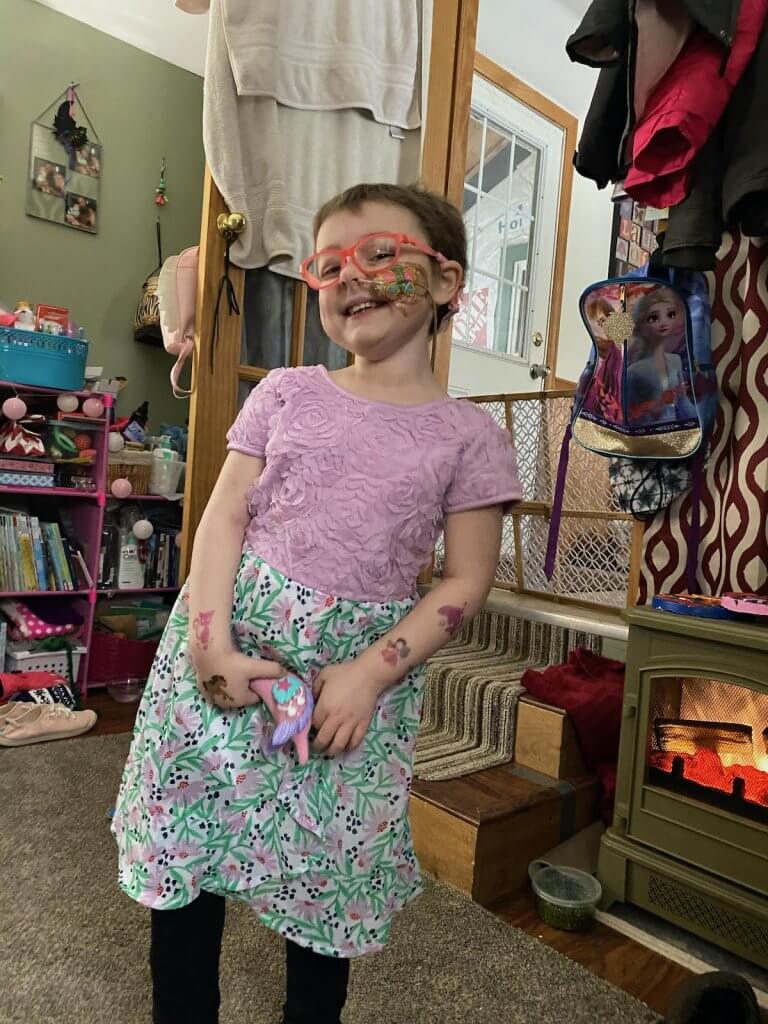When Samantha Price’s four-year-old daughter, Shelby, was diagnosed with acute lymphoblastic leukemia (T-ALL) in October 2019, Price had so many questions about what the future held for both of them. What would the highs and lows of treatment look and feel like for Shelby, and how could she best care for her daughter throughout the emotional and physical rollercoaster ride?
Price found answers, and unwavering support, from Dana-Farber’s Pediatric Psychosocial Oncology Program team. She has pediatric oncology social worker Larissa Hewitt, LICSW, on speed dial for guidance whenever anxiety, treatment side effects and other factors throw both Shelby and Price for a loop.
“Larissa is always there,” Price says.
Evaluating each family’s support needs

Hewitt and her fellow psychosocial teammates work with families to support their emotional health throughout their child’s treatment journey. They typically meet with families shortly after diagnosis to conduct an assessment to identify their specific support needs. The assessment then helps determine a plan for ongoing support.
“There is no right or wrong way to use psychosocial support services,” Hewitt notes. “Some families are very closely connected to us throughout the course of treatment. Others just benefit from knowing we are there if or when they need us.”
Price has fully embraced the help on offer from the start.
“A couple of weeks into treatment, Shelby would get extremely anxious and upset when we would arrive at the clinic,” Price recalls. “Larissa would come into the room to keep us company. She’d read Shelby a Curious George book, blow bubbles, or just calmly talk to her as a distraction, which was a huge help.”
Adopting helpful hints at home
Hewitt coached Price on how to use the same redirection techniques at home, especially when steroids amplify Shelby’s mood swings and make it more difficult to calm her down.
“Shelby likes to take baths,” Price says. “On days like that, we might take up to three baths a day to redirect her energy and focus.”
With guidance from Hewitt, Price has changed how she communicates with Shelby about what lies ahead each time they make the hour drive from their home in Lunenburg, Mass., to Dana-Farber.

“At the beginning, we would just show up at the hospital, do what we had to do and go on about our business,” Price says. “But now I talk Shelby through what will happen ahead of time. It helps tremendously with her anxiety. If she knows what to expect, who she will see and has a general idea of what the day is going to look like, she is good to go.”
Oftentimes, Shelby’s day in clinic includes individual time with Hewitt to practice pill swallowing, a challenge for younger patients. That practice has paid off.
“There are times at home when Shelby will take the sprinkles off of a cupcake, put them on her tongue like a pill, then swallow them with water just as Larissa has taught her,” Price says. “It’s so great seeing her do that on her own.”
Now that Shelby is nearly 18 months into her treatment, Price feels more comfortable reaching out to new families she meets in the waiting room and sharing her experiences.
“I’d tell families to use all the resources you can, including Parents Together,” she says. “They (the psychosocial support team) are always there. They want to help the best they can and be there as an emotional support not only for your child, but for your whole family.”
Dana-Farber’s Parents Together website serves as a central hub where parents of pediatric oncology patients can find information sheets and instructional videos on such common challenges as pill swallowing, nausea management and good nutrition.
